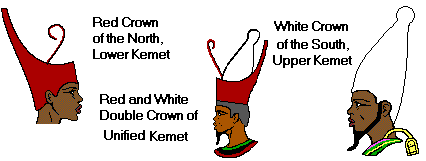In Ancient Egypt, there were a number of different Egyptian Crowns that could be worn by the Kings, the Gods, and the Royal Women. The most frequently depicted, and easily recognizable of the crowns worn by the kings of Ancient Egypt was the Red Crown – Deshret (Crown of Lower Egypt), the White Crown – Hedjet (Crown of Upper Egypt) and the Double Crown – Pshent (symbolizing the Unification of Upper and Lower Egypt).
In ancient Egypt, there were a number of different types of crowns, mostly worn by gods, kings, and queens and sometimes their children. Sometimes, as in the case of the Red and White crowns, they could also be combined to form a special symbolism, such as in this case, the unity of Upper and Lower Egypt under one rule. Gods and kings were never represented without one because they indicated important aspects of both royalty, divinity, and of Egypt itself.

Egyptian Crowns and headdresses were mostly made of organic materials and have not survived but we know what they looked like from many pictures and statues. The best-known crown is from Tutankhamun’s golden death mask.
Nemes Egyptian Crowns
This was called the Nemes crown (shown above) and was made of striped cloth. It was tied around the head, covered the neck and shoulders, and was knotted into a tail at the back. The brow was decorated with the “uraeus,” a cobra and vulture.
The political and religious significance of crowns for the image of the king can be inferred from the fact that different headdresses were favored in different periods. Thus, some types of crown do not appear in the Amarna period, as an example. Akhenaten’s queen Nefertiti wore crowns confined to the king in other periods, such as the cap crown, and new crown types were invented for her, apparently to symbolize her expanded role.

Funerary literature from the period of the Pyramid and Coffin Texts on provides that crowns are an important role to play int he rites of passage that transform the deceased into an inhabitant of the sky. Endowing him with divine attributes such as radiance, they both lien the dead king to the gods of the sky and impart to him authority over them.
The crowns were symbols of wealth and power, which had to be given up when one was defeated in battle. They were used to show appreciation for services rendered when they were bestowed upon deserving soldiers or officials. They were a means to impress one’s status, one’s dominance and one’s opulence upon others by distributing them as largesse.